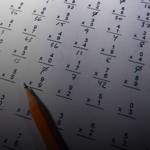Section 1
Preview this deck
elimination method
Front
Active users
0
All-time users
0
Favorites
0
Last updated
5 years ago
Date created
Mar 1, 2020
Cards (88)
Section 1
(50 cards)
elimination method
a method used to solve systems of equations in which one variable is eliminated by adding or subtracting two equations of the system
dependent variable
The output of a function; a variable whose value depends on the value of the input, or independent variable.
sequence
A list of numbers that often form a pattern.
like terms
terms whose variables and their exponents are the same
dependent system
a system of equations that has infinitely many solutions
domain
The set of all inputs (generally x-values) of a relation or function.
arithmetic sequence
A sequence whose successive terms differ by the same nonzero number, called the "common difference".
function
A relation in which ever domain value is paired with exactly one range value.
residual
the signed vertical distance between a data point and a line of fit
inconsistent system
a system of equations or inequalities that has no solution
whole number
A member of the set of natural numbers and zero
Exponential Decay
An exponential function in this form, where r is the rate of decay, a is the initial amount and t is the time.
Exponential Expressions
An algebraic expression in which the variable is in an exponent with a fixed number as the base.
substitution method
A method used to solve systems of equations by solving an equation for one variable and substituting the resulting expression into the other equation(s)
monomial
a number or a product of numbers and variables with whole-number exponents, or a polynomial with one term
common difference
In an arithmetic sequence, the nonzero constant difference of any term and the previous term.
compound inequality
two inequalities that are combined into one statement by the word "and" or "or"
Y-Intercept
The y-coordinate(s) of the point(s) where a graph intersects the y-axis.
Exponential Growth
An exponential function in the form y=a(1+r)^t, where r is the rate of growth, a is the initial amount and t is the time.
empty set
a set with no elements
correlation
a measure of the strength an direction of the relationship between two variables or data sets
relation
A set of ordered pairs.
factor
a number or expression that is multiplied by another number or expression to get a product
real number
A rational or irrational number. Every point on the number line represents a real number.
X-Intercept
The x-coordinate(s) of the point(s) where a graph intersects the x-axis.
Linear Function
A function that can be written in the form y=mx+b, where x is the independent variable and m and b are real numbers. Its graph is a line.
Exponent
The number that indicates how many times the base in a power is used as a factor.
binomial
a polynomial with two terms
Exponential Function
A function in the form f(x)=ab^x where a and b are real numbers, a does not equal zero, b>0, and b does not equal 1.
linear regression
a statistical method used to fit a linear model to a given data set
Base
The number in a power that is used as a factor.
function notation
If x is the independent variable and y is the dependent variable, than the function can be written as f(x), where f names the function.
Half-life
The half-life of a substance is the time it takes for one-half of the substance to decay into another substance.
Slope
A measure of the steepness of a line.
Perfect Square
A number whose positive square root is a whole number.
Rate
A ratio that compares two quantities measured in different units.
independent variable
The input of a function, a variable whose value determines the value of the output, or dependent variable.
range
The set of all outputs (generally y-values) of a relation or function.
inequality
a statement that compares two expressions by using "less than" "greater than" "less than or equal to" or "greater than or equal to"
system of linear equations
a system of equations in which all of the equations are linear
polynomial
a monomial or a sum or difference of monomials
function rule
an algebraic expression that defines a function
correlation coefficient
a number r greater than or equal to -1 and less than or equal to 1, that describes how closely the points in a scatter plot cluster around the line of best fit.
irrational number
A real number that cannot be expressed as the ratio of two integers.
independent system
a system of equations that has exactly one solution
rational number
A number that can be written as the ratio of two integers.
constant
a value that does not change
consistent system
a system of equations or inequalities that has at least one solution
interval
The numbers between two specific values.
Rate of Change
A ratio that compares the amount of change in a dependent variable to the amount of change in an independent variable.
Section 2
(38 cards)


